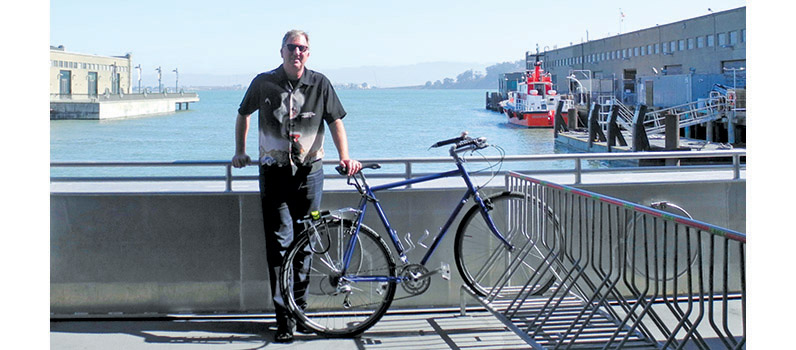You might be on a ferry right now, or about to hop on board, or you may be savoring the lovely cruise you just took across the Bay.

WETA Planning and Development Manager Kevin Connolly rides a bike from his Alameda home to Jack London Square and then takes the San Francisco Bay Ferry to work. His firsthand experience as a ferry rider gives him a deeper understanding of the issues important to commuters.
BY MATT LARSON
Published: October, 2018
You might be on a ferry right now, or about to hop on board, or you may be savoring the lovely cruise you just took across the Bay. No matter what, your trip is an important part of the story of public transit on the Bay. Many entities throughout the Bay Area are constantly assessing public ridership, and some positive changes are on the horizon.
The Water Emergency Transportation Authority (WETA) has many projects in the works. On a large scale, WETA is prepared to be fully operational in the event of a major disaster, but its daily operations consist of providing passenger ferry services all throughout the Bay.
Many ferry riders have noticed that ridership has grown, but you may not know the extent of the boom: “Our ridership has grown 98 percent in the last four years,” said WETA Planning and Development Manager Kevin Connolly. “Each year we’ve had double-digit ridership growth, so we are doing a lot to try to catch up.”
Connolly grew up in the South Bay and has worked in transportation for 20 years, which included time working in transit, including working for BART and for VTA in San Jose. He currently lives in Alameda, rides his bike to Jack London Square and takes the ferry to work every day—just like us. “So I experience it firsthand,” he said, which helps give him an even deeper understanding of an average commuter’s transportation needs.
At this writing, Connolly and the WETA team have three projects under construction that are all scheduled for completion within the next year or so: a new maintenance facility in Alameda; an expansion of the ferry plaza and a doubling of WETA’s gates at the downtown San Francisco Ferry Terminal; and—drumroll please—an all-new ferry stop in Richmond, set to open on January 10, 2019.
WETA is about to begin construction on new terminals at Sea Plane Lagoon in Alameda and at Mission Bay in San Francisco next to the new Warriors arena. Farther into the future, you can also look forward to even more ferry stops at Treasure Island, Redwood City and Berkeley—all of which are to be completed in about seven years or so.
“We’re striving to provide enough service so that people don’t have to look at a schedule,” Connolly said. “They’ll know that a boat is leaving every 10-15 minutes and people will just show up.”
In Vallejo, for example, demand often outpaces supply and the boats fill up fast. “Today our biggest boat is 350 passengers in Vallejo,” he said. “By 2020, we’ll add four boats that are all 450-passenger vessels, plus we’re going to have a lot more frequency—leaving just about every 20 minutes.”
Even with so much responsibility to plan for the future of our bustling Bay, Connolly manages to reserve some time to coach youth basketball. He also enjoys taking his sea kayak out in the Bay. To his fellow kayakers, Connolly’s got the inside scoop. The new Richmond terminal required relocating a kayak launch that was in the same area needed for terminal construction—but it’s working out for the best. “We built probably the nicest kayak launch in the whole Bay in Richmond, and it’s about to open next month,” he said. “It’s designed to be accessible for disabled kayakers, making it easier for people with wheelchairs to move their boats on and off the facility.”
So look forward to bigger boats, more frequent service, new terminals and much, much more—including a mobile fare app slated to be ready for download this fall. Our ever-popular ferry system is growing each and every day, and for good reason. “It’s just so unique, and interesting, and relaxing,” he said. “You just can’t help but get off the boat at the end of your trip and be in a calmer state. It’s like nothing else.”

